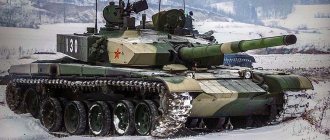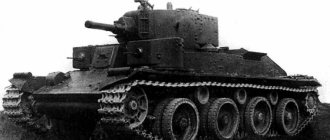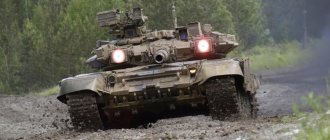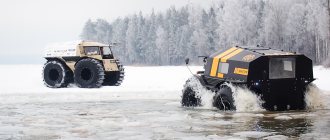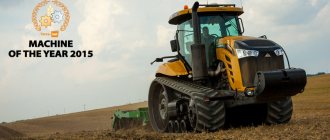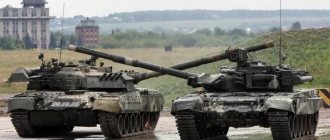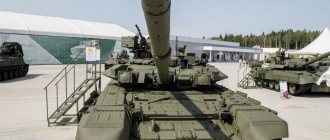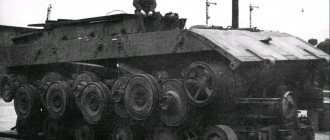In modern military conflicts, tanks play an important role in achieving victory over the enemy. These combat vehicles began to be actively used at the beginning of the last century.
In this article we will look at the very first tanks in the world , differing in shape, type of movement and number of combat units. Fans of various inventions and everything will be interesting.
The world's first tanks were strikingly different from the tanks we are used to seeing. At the initial stage of their development, they were war chariots.
After this, mobile towers and Wagenburgs were constructed - field fortifications made from wagons. However, all these structures moved due to the traction force of animals, which could simply be killed on the battlefield.
For this reason, people thought about creating fortifications that could move without the help of horses or elephants.
Acquaintance
The KV-1S tank (a photo of the combat unit can be seen below) is one of the models of heavy armored vehicles produced by the defense industry of the USSR. Soviet heavy tanks produced from 1940 to 1943 are designated by the abbreviation KV. What does the Klim Voroshilov 1C mean in the tank? This index indicates that the combat unit is fast and the first model of the entire series of tanks.
M10 Wolverine
On the first American TD with a turret, “Wolverine,” the bad feelings that begin to visit the player as early as T40 are completely justified. Let's say hello to the M1A1 and M1A2 guns - you've missed them since the days of the Sherman M4A3E8, right? And the guns seem to be quite good - fast-firing, quite accurate and penetrate everything that is needed... But the figures for the damage done are not at all encouraging: 115 units is, whatever one may say, not enough. Especially considering that the M10 is still not the M4A3E8, it won’t be possible to spin a heavy tank by bombarding it with shells.
| The M4A2E4 is the only Sherman with a bad gun. |
However, the Wolverine has one outlet - the 105mm AT SPH M4 L/23. A gun adapted to fire high-explosive shells can stun almost anyone - the main thing is to be clever and still hit. But you can play with it, as a decent tank destroyer should - sit in ambush, wait for the enemy to arrive on his own, and destroy him with a couple of shots. And if it is something like the T-28, one hit will be enough.
| NOTE: the second of the available M10 turrets does not provide any visible advantage (apart from a slight increase in the strength of the self-propelled gun). The most important thing is not reflected in the research window - it increases the gun’s rate of fire. |
The turret on a tank destroyer, on the one hand, is a big plus. With it you can track a target without fear of accidentally turning the body and giving away your location. And you can choose better positions - if for other anti-tank self-propelled guns stones and low walls were an unpleasant obstacle, then the Wolverine, due to the high position of the gun, on the contrary, likes to hide behind a wall so that only the turret is visible from behind it.
But on the other hand, this spinning thing causes nothing but frustration. And most importantly: the M10 turret is open at the top, which means that high-explosive charges will almost certainly cause complete damage to it - especially high-explosive charges arriving from above, from artillery - shell-shocking the crew and often exploding the ammunition rack. In addition, there is a psychological factor: the presence of the turret simply encourages you to play this vehicle as a medium tank with a completely natural, sad ending...
| This Czech tank clearly shows how impressed the Germans were with the Soviet T-34. |
Start of creation
Already by 1942, the military noticed that KV tanks were not ideal. Due to their large mass, it was difficult to operate them, which negatively affected the combat efficiency of the equipment. Also, the tank did not operate at full engine power. The reason for this is problems in the system cooling the engine. As a result, to prevent overheating of the power unit, it had to be used in low-speed mode. In addition, the tank was not equipped with a commander's cupola, which significantly limited all-round visibility. The military was also not satisfied with the inconvenient location of the viewing devices. Some components in the diesel engine were defective. These shortcomings were reported to the State Defense Committee, which in February 1942 issued Resolution No. 1334ss. According to this document, the designers of ChTZ (Chelyabinsk Tractor Plant) were faced with the task of designing a tank weighing 45 tons and with an engine whose power should be 560 horsepower. Three days later, the People's Commissariat of Defense signed decree No. 0039 on the start of work on the creation of the KV-1S tank.
Initially, they decided to reduce the permissible weight of 45 tons by reducing the width of the track to 60 cm, the thickness of the armor in the bottom and in the frontal part. In addition, changes were to be made to the ammunition load - it was decided to reduce it to 90 shells. The KV-1S tank (there is a photo of the model in the article) was produced without additional fuel tanks.
Tank by Leonardo da Vinci
At the end of the 15th century, the great Leonardo da Vinci (see interesting facts about Leonardo da Vinci) managed to design a tank made of wood and metal. It was shaped like a spinning top.
The inventor placed cannons along the perimeter of the circle. Such an unusual machine had to be driven through complex mechanisms. This allowed the Renaissance tank to move across the surface autonomously.
However, Leonardo's ideas were so ahead of the time in which he lived that the project remained only on paper. An interesting fact is that in 2009, American engineers were able to recreate the tank according to the drawings of the great Italian.
About production
Design work was carried out in the design bureau of the tractor plant in the city of Chelyabinsk. Soon a prototype tank with a 650 hp V-2K engine was ready. With. and new final drives. However, during testing it turned out that the power unit was ineffective. The opposite situation was observed with final drives, which it was decided to leave. Later, their serial production was established. In April, they tested a new gearbox designed for 8 speeds and a 700 hp engine. With. According to experts, it was not possible to fully test the engine, and the KV-1S tank soon began to be equipped with a gearbox. In total, the Soviet defense industry produced 1,120 combat units.
T25 AT
The choice of weapons here is also small, but this is not the main thing. The 105mm AT Gun T5E1 (remember it from the T29, right?) is quite suitable for a level seven self-propelled gun. And the gun comes with excellent maneuverability - the base from the T23 medium tank helps - and good armor with inclined armor plates, from which enemy shells ricochet with good frequency. In addition, another advantage of the T25 is its wide vertical gun pointing angles. The self-propelled guns that boarded it unexpectedly discovered that they could fire almost from behind the crests of hills - this “profile” property of American tanks on self-propelled guns is very rare.
| This self-propelled gun has a lot in common with the German Jagdpanther, but the American is still a little better. |
About the design
The Soviet heavy tank KV-1S is a modernization of the first original model, which is listed as the KV-1. The main goal pursued by the designers was to make the new combat unit more reliable and faster. As a result, unlike its counterpart, the KV-1S tank, due to weakened armor, has a less massive hull and is equipped with a new, more advanced turret and gearbox. The Chelyabinsk designers decided not to change the armament and motor group. The Soviet KV-1S tank came with a classic layout, typical of heavy and medium models produced at that time by the Soviet defense industry. The vehicle consists of three compartments: management, combat and engine-transmission. In the first there is a place for the driver and gunner-radio operator, the second - for crew members. The fighting compartment was combined with the middle part of the hull and the turret.
There is also room for the main gun, its ammunition and fuel tanks. The stern of the KV-1S tank was equipped with an engine and transmission.
E-75
This Tier 9 heavy tank can be mistaken for a “Royal Tiger” from afar. But it’s not worth it - the “seventy-fifth” may be offended and stung painfully by a shot from the “top” gun 12.8cm KwK 44 L/55 - the same one that was installed on the VK4502 Ausf. B, and on "Mouse". Compared to the Porsche “slipper”, the E-75 lost thirty units of life and ten millimeters of frontal armor. But it increased the side by twenty millimeters, which should have been pleasing, if not for one “but”: in the event of a successful shot, the projectile passes by these 120 mm and digs into the lower part of the hull, where the armor is only 14 millimeters. It’s especially scary when a landmine does this, which otherwise could not penetrate the armor of the E-75... However, the developers have already recognized this fact as an error in the tank model and promised to correct it.
| The E-75 in attack is a beautiful sight. Or scary. It depends on which side of the trunk you are on. |
In addition to the difference in hit points and armor, the E-75 has another advantage over the VK4502 Ausf. B - purely constructive in nature. Its turret is not shifted back, like the Porsche prototype, which means that when switching to it from a CT, you won’t have to change your playstyle as much as before.
About armor protection and a tank turret
In the production of the high-speed tank “Klim Voroshilov” (a photo of this combat unit can be seen in the article), rolled armor plates were used, the thickness of which was 2, 3, 4, 6 and 7.5 cm. The vehicle had differentiated ballistic armor protection. The turret in the tank has a complex, streamlined shape and was made by casting. In order to increase its projectile resistance, the designers positioned the side of the tower at an angle of 75 degrees in the vertical plane. The sides, according to experts, had the greatest thickness - 75 mm. An embrasure for a cannon was also placed in the frontal part of the tower. This part was cast separately. Then they were connected to the rest of the armored parts by welding. The gun mantlet was made on the basis of a rolled armored plate, which was bent and equipped with three holes for a cannon, a coaxial machine gun and a sight. The result was a product in the form of a cylindrical segment with a thickness of 8.2 cm. The turret was placed on the cover in the fighting compartment on a shoulder strap, the diameter of which was 153.5 cm. To prevent it from falling off when the tank rolled strongly, it was securely fixed with special grips.
T82
The icon of this tank destroyer in the command lists initially caused a lot of comments in the battle chat. The self-propelled gun based on the light Stuart has many nicknames; the two most characteristic ones are “Pull-Push” and “Catdog”.
But laughter is laughter, and when a light tank, trying to spin the T82, suddenly realizes that what it thought was the stern is actually the front part, from which a 105-mm land mine is already flying at it, the smile disappears somewhere by itself. That’s right: 105 mm on a tier 3 tank is not a joke, it’s very serious.
| Keep in mind that where the gun is, there is the front. And it’s better not to approach from that side - it will bite. |
But if the accuracy of a short-barreled high-explosive weapon is still not enough for you, you can change it to the 57mm Gun M1 L/50, which also has an average armor penetration of 110 mm and a rate of fire of about 30 rounds per minute. The damage, however, is only 75 units, but for the level of this self-propelled gun it is quite enough.
In addition to its weapons and silhouette, the T82 also pleases with its speed: it reaches its 48 km/h willingly and maneuvers perfectly, allowing you to take advantageous positions and retreat in case of danger.
Inside a Soviet high-speed tank
The driver's workplace is the front part of the hull in the center. The radio operator gunner is to his left. A combat crew of three people was housed in the turret. The gunner and vehicle commander sat to the left of the gun, and the loader to the right. The commander had a cast observation turret, the armor of which was 6 cm thick. For the landing and exit of the combat crew, two round hatches were provided in the tank. One of them was under the loader, the second was in the top cover of the housing above the gunner-radio operator. In addition, the KV-1S was equipped with a bottom emergency hatch. Repair of components and assemblies of the machine was carried out through additional small technical hatches. Through them it was possible to get to the fuel tanks, as well as load ammunition into the tank.
T40
Both the M3 Lee tank itself and the self-propelled guns based on it have not yet been particularly impressive. M3 is sincerely hated by some players, and sincerely loved by others; The absence of a turret and the strangely mounted gun on the right side of the hull have an impact. In general, having learned that the T40 was assembled on the basis of the M3, I bought it with apprehension...
| This is what a proper M3 Lee looks like. And for some reason they tried to attach a tower to it... |
...A completely unjustified fear. Although the first bell rang, warning of future difficulties: the best of the available guns, the 76 mm AT Gun M1A1 - an old friend, memorable from the Shermans and T1 heavy, which for the sake of appearance had attached the AT index, meaning a self-propelled version. But, firstly, for a fourth-tier tank destroyer this weapon is excellent both in terms of damage and armor penetration. And secondly, the horizontal guidance angles of the T40 are such that, perhaps, even Marder II would envy them, and they force the driver of this car to forget about everything else, relax and enjoy the process. Speed and maneuverability are also good - it is quite possible to “carousel” a KV-2 on it.
About weapons
The battle on the KV-1S tank was fought with a 76.2-mm ZIS-5 cannon. The weapon was mounted on trunnions. The aiming was carried out in the vertical plane from -5 to 25 degrees. Shooting was carried out using mechanical and electric triggers. The main gun could fire 114 shots. Ammunition for it lay in the turret along the sides. In addition, it was possible to hit the enemy with three 7.62 mm DT machine guns. One of them was paired with a ZIS-5, the second was a forward-moving one, and the third was placed at the rear of the tank on a special ball mount. The combat set of small arms was represented by 3 thousand cartridges. The DT machine guns were installed in such a way that the crew could remove them at any time and fire them separately from the KV-1S. The crew also had several F-1 hand grenades. The tank commander was entitled to a signal pistol.
Heavy tank KVSerial heavy tank KV-1 with a welded turret and L-11 cannon. 1940
Breakthrough tank. Developed in 1939 at SKB-2 of the Kirov plant (Leningrad) as a single-turret version of the experimental SMK tank. Adopted by the Red Army by Decree of the KO at the Council of People's Commissars of the USSR No. 443ss dated December 19, 1939. Produced at the Kirov Plant, Chelyabinsk Tractor Plant and Chelyabinsk Kirov Plant. From February 1940 to October 1943, 4771 units were manufactured.
DESIGN AND MODIFICATIONS
KV-1 arr. 1940 – first production version. The hull and turret are welded. box-shaped Cast turrets were installed on parts of the tanks. Combat weight 47 tons. Dimensions 6675x3320x2710 mm. V-2K engine. Armament: 76 mm L-11 cannon and 4 DT machine guns (1 spare). Ammunition 111 rounds. 3024 rounds. Armor 30…75 mm. Some of the tanks had shielded armor. Crew 5 people 142 units produced.
Serial tank KV-1 produced in 1941 with an F-32 cannon. Judging by the rectangular additional fuel tanks on the fender, this vehicle was manufactured after the start of the war
A column of repaired KV-1 tanks on the way to the front. Leningrad, spring 1942
KV-1 arr. 1941 - 76-mm F-32 cannon with a barrel length of 31.5 calibers, Since October 1941. – 76-mm ZIS-5 gun with a barrel length of 41.5 caliber. Additional fuel tanks on the fenders. Some tanks have turrets of a simplified design, shielded armor, and M-17 carburetor engines.
KV-2 is a large welded box-shaped tower. The first 46 cars had a different shape from the subsequent ones. Combat weight 52 tons. Dimensions 6950x3320x3250 mm Armament: 152 mm M-10 howitzer and three DT machine guns. Ammunition 36 rounds of separate loading and 3087 rounds of ammunition Crew 6 people. 213 units produced.
KV-1S is a streamlined cast turret with a commander's cupola. The weight of the power transmission and chassis units has been reduced. Reduced armor thickness. New gearbox introduced. 1048 units produced.
KV-1 tank with a simplified turret, manufactured at the Kirov plant in Leningrad in the fall of 1941.
The crew of the shielded KV-1 tank receives a combat mission, Northwestern Front, 1941.
KB-8S (object 239) – KV-1S with a new turret and 85 mm D-5T cannon. The turret is cast, streamlined, with a commander's cupola. Ammunition 70 rounds and 3276 rounds. The ball mounting of the forward machine gun was eliminated. Combat weight 46 tons. Dimensions: 3493x3250x2800 mm. Crew 4 people 148 units produced.
As of June 1, 1941, the troops had 504 KV tanks. Of this amount, most were in the Kiev Special Military District - 278 vehicles. The Western Special Military District had 116 KV tanks, the Baltic Special - 59, the Odessa - 10. The Leningrad Military District had 6 KV tanks, the Moscow - 4, the Volga - 19, the Oryol - 8, the Kharkov - 4. Of this number 75 KV-1 and 9 KV-2 were in operation (of which 2 and 1, respectively, required medium repairs). From June 1 to June 21, another 41 KV tanks were sent to the troops from the plant.
In the very first days of the Great Patriotic War, both the obvious advantages and disadvantages of the new heavy tanks, as well as all the shortcomings in the combat training and organizational structure of the tank forces of the Red Army, were fully revealed. In 1941, the KV could hit any tank of Hitler's Wehrmacht, while remaining practically invulnerable. The most effective means of combating it were 88-mm anti-aircraft guns and aircraft. A significant number of these combat vehicles were abandoned on the battlefield due to breakdowns of technically deficient transmissions.
Heavy tank KV-2 (pre-production model of the U-7 with the first MT-2 turret) before testing. September 1940
In July-September 1941, the largest number of KV tanks was available on the Leningrad Front, since it then received almost all of the KVs produced by the Kirov Plant. Indeed, not a single front could afford to have separate battalions of KV tanks at that time. while there were several of them near Leningrad, not counting the KVs as part of other tank units. For example, on September 11, Major Zhitnev’s battalion arrived as part of the 42nd Army, which had 29 KV tanks and the 51st tank battalion (16 KV, 1 T-34, 12 BT, 9 T-26). Nevertheless, they were unable to radically change the situation - at the end of September 1941, Leningrad found itself in a blockade ring. The fighting here took on a positional character.
In other sectors of the Soviet-German front, KV operations were even less active, since the number of tanks lost in battles grew faster than their arrival from industrial plants - the Kirov plant was under blockade and the production of KVs in Chelyabinsk was just beginning.
The first Chelyabinsk KV-1 tanks with ZIS-5 guns took part in the battles near Moscow in the fall of 1941, given the difficult situation on the outskirts of the capital. The Supreme High Command headquarters decided to send most of the new heavy tanks to the defense of Moscow. According to the existing states, the tank brigades had a company of heavy KV tanks - seven or ten vehicles. In addition, the separate tank battalions included a company of KV tanks - ten vehicles.
In addition to tank brigades and battalions, KV tanks were sent directly to the commanders of the armored and mechanized forces of the fronts to replenish units already conducting combat operations. For example, in May 1942, 128 KV tanks were shipped to replenish the troops - 28 to the Bryansk, 20 to the Kalinin, 30 to the Crimean fronts and 40 to the South-Western direction. At the beginning of July 1942, the formation of separate KV tank battalions of 15 vehicles and separate tank companies of 10 vehicles each began.
Tank KV-1 with a cast turret and hull, produced by plant No. 200. Spring 1942
Tank KV-1 with a cast turret manufactured by UZTM. Pushkinskaya Square in Moscow, January 1942
The use of HF in the spring of 1942 on the Crimean Front and near Kharkov was unsuccessful. During muddy times, heavy tanks failed in large numbers due to gearbox failures. At the same time, as an infantry support tank, the KV had no equal - its thick armor and large silhouette allowed infantrymen to reliably take cover behind the tank during an attack. In addition, when moving in first gear, the speed of the HF was the same as that of the soldiers going on the attack.
By the end of 1942, most of the KV-1 tanks were lost.
They remained in units for quite a long time in stable sectors of the Soviet-German front - the Leningrad, Volkhov and Karelian fronts. A small number of KV-1s took part in the battles on the Kursk Bulge in the summer of 1943, and individual tanks fought until the fall of 1944. TACTICAL AND TECHNICAL CHARACTERISTICS OF THE KV-1 TANK mod.
1941 COMBAT WEIGHT, t: 47.5.
CREW, people: 5.
OVERALL DIMENSIONS, mm: length – 6900, width – 3352, height – 2710, ground clearance – 450.
ARMAMENT: 1 ZIS-5 cannon model 1941, 76 mm caliber, 4 DT machine guns model 1929, 7.62 mm caliber,
AMMUNITION: 114 rounds, 3024 rounds. AIMING DEVICES: telescopic sight TMFD-7, periscopic panoramic sight PT-4-7.
RESERVATION, mm: front and side of the hull – 75, stern – 60..75, roof and bottom – 30,..40, turret – 75.
ENGINE: V-2K, 12-cylinder, four-stroke, diesel, V-shaped, liquid cooling; power 500 hp (368 kW) at 1800 rpm, displacement 38,880 cm3
TRANSMISSION: multi-disc dry friction main clutch, five-speed gearbox, final clutches, planetary final drives.
CHASSIS: six track rollers with internal shock absorption on board, three rubberized support rollers, a guide wheel, a rear drive wheel with a removable ring gear (pinion engagement); individual torsion bar suspension; each caterpillar has 87 - 90 tracks with a width of 700 mm.
MAX. SPEED, km/h: 34.
POWER RESERVE, km: 250.
OBSTACLES TO OVERCOME: ascent angle, degrees. – 36, ditch width, m – 2.7, wall height, m – 0.87, ford depth, m – 1.6.
COMMUNICATIONS: radio station 71-TK-Z, intercom TPU-4 bis.
KV-1 tanks of the 116th Tank Brigade. Western Front, April 1942. The Shchors tank has a cast turret, while the Bagration tank has a welded turret.
Tank KV-1 in Vyborg. Leningrad Front, 26th Guards Breakthrough Tank Regiment, June 23, 1944
KV-1S tanks began to enter service with the troops in November - December 1942. They equipped special tank units - Guards breakthrough tank regiments, which had 214 personnel and 21 KV-1S or Churchill tanks. The title “Guards” was assigned to these regiments immediately, in accordance with the directive of the Supreme High Command Headquarters. These regiments were attached to rifle and tank formations and were intended to break through enemy defenses.
The breakthrough regiments received their baptism of fire on the Don and Voronezh fronts at the end of 1942. KV-1S tanks were also actively used in the summer campaign of 1943. For example, the 6th Guards breakthrough tank regiment in May-June 1943 operated as part of the troops of the North Caucasian Front. Several regiments also took part in the battle of Kursk. Thus, the Central Front had 70 KV tanks, and the Voronezh Front had 105, which was only 5% of the total number of tanks on these two fronts. So the KV tanks did not make a significant contribution to the defeat of the enemy in the Battle of Kursk. The 1st Guards Tank Breakthrough Regiment took part in the breakthrough of the so-called “Mius Front” in July - August 1943, which suffered heavy losses on the first day of the offensive, amounting to up to 50% of combat vehicles - two KV tanks burned out, two were knocked out and six were blown up by mines.
From September 1943, KV-85 heavy tanks began to enter service with the Guards breakthrough tank regiments.
Heavy tank KV-1S manufactured at the end of 1942 at the Kubinka training ground
The last Guards breakthrough tank regiment was formed in January 1944, and by the fall all these regiments were disbanded or reorganized into Guards heavy tank regiments receiving IS tanks. The KV-1S and KV-85 that remained in service were transferred to other breakthrough regiments and to ordinary tank regiments, in which they took part in the combat operations of the Great Patriotic War until mid-1944, and individual vehicles until May 1945.
In addition, KV-1S were used as command vehicles in heavy self-propelled artillery regiments.
KV tanks served as the basis for the creation of self-propelled artillery mounts and flamethrower tanks. In 1944, some of the vehicles were converted into evacuation tractors.
KV-1 tanks on the attack. Kalinin Front, January 1943
KV-1S from the Soviet Polarnik tank column before the battle. 5th Guards Breakthrough Tank Regiment, Don Front, December 1942.
Heavy tank KV-85. 1943
On the march is a KV-1S of the 6th Guards Breakthrough Tank Regiment.
April 1943 TACTICAL AND TECHNICAL CHARACTERISTICS OF THE KV-1 TANK
COMBAT WEIGHT, t: 42.5.
CREW, people: 5.
OVERALL DIMENSIONS, mm: length – 695Q, width – 3250, height – 2640, ground clearance – 450.
ARMAMENT: 1 ZIS-5 cannon model 1941, 76 mm caliber, 4 DT machine guns model 1929, 7.62 mm caliber
AMMUNITION: 114 rounds, 3087 rounds.
AIMING DEVICES: telescopic sight 10T, periscopic panoramic sight PT-4-7.
RESERVATION, mm: front and side of the hull - 75, stern - 40...75, roof and bottom - 30,..40, turret - 82.
ENGINE: V-2K, 12-cylinder, four-stroke, diesel, V-shaped, liquid cooling; power 500 hp (368 kW) at 1800 rpm, displacement 38,880 cm #179;.
TRANSMISSION: multi-disc main dry friction clutch, eight-speed gearbox with a range multiplier (8+2), side clutches, planetary final drives.
CHASSIS: six track rollers on board, three support rollers, a idler wheel, a rear drive wheel with a removable ring gear (pinion engagement); individual torsion bar suspension; each caterpillar has 88 - 89 tracks with a width of 608 mm,
MAX. SPEED, km/h: 43.
POWER RESERVE, km: 200.
OBSTACLES TO OVERCOME: ascent angle, degrees. – 36, ditch width, m – 2.7, wall height, m – 1, ford depth, m -1.6.
COMMUNICATIONS: radio station 9P or 10P, intercom TPU-4 bis.
Table of contents
About the power unit
The tank used a four-stroke V-shaped 12-cylinder diesel engine V-2K. The engine power was 600 horsepower. To start the unit there was an ST-700 starter (15 hp). Also for this purpose, compressed air was used, contained in two 5-liter tanks in the combat compartment. The volume of the main fuel tanks was 600 and 615 liters. Their location was the combat and transmission compartments. Additionally, the tank had four more external fuel tanks that were not connected to the general system. Each container is designed for 360 liters of fuel.
Advantages and disadvantages
Advantages:
- a powerful 152 mm howitzer capable of destroying any fortification;
- the successful V-2 diesel engine, which was subsequently installed on all tanks;
- reliable armor protection, which has no analogues from the enemy.
Flaws:
- weak chassis that does not correspond to the combat weight;
- low rate of fire due to separate loading of the howitzer;
- imperfect, difficult-to-use transmission;
The KV-2 heavy tank became a significant stage in the development of Soviet tank building. It was far from perfect, even by the standards of those years. But this is the result of persistent search, new developments, and the work of hundreds of designers, engineers, and workers.
He retained much of this and “passed it on” to its successor, the IS-2 tank, which turned out to be so successful that it remained in service with the Soviet (Russian) armored forces until 1995.
About the transmission
The KV-1S was equipped with a transmission, which consisted of the following components:
- Multi-disc main dry friction clutch.
- Four-speed gearbox using a range multiplier (8 forward gears and 2 reverse).
- Two multi-disc onboard clutches.
- Two onboard planetary gearboxes.
Tank with mechanical control drives. According to experts, a significant drawback of the Klim Voroshilov combat vehicles was that the transmission was not reliable enough. With the new gearbox this flaw was corrected. Later they decided to use it in the IS-2 model.
M36 Slugger
But this self-propelled gun with guns is quite sad: either the basic M1A2, or the 90mm AT Gun M3. After all, American designers were too carried away by the standardization of weapons and did not think at all about the future players of the World of Tanks!
But jokes are jokes, and the 90-mm gun “Made in USA” copes with the assigned tasks quite well. The damage, of course, is not enough, but it is bearable. Moreover, the M36 is already more or less adequately armored - even if only in the front, but that’s good. At the very least, you can ignore every little detail, and with a bit of luck and the correct positioning of the tank, you can achieve “non-piercing” even from the guns of the German “Tiger”.
| Specialized tank destroyers with rotating turrets are a purely American invention. The cover for the tower was invented by those who had to fight on it. |
The problem of the open turret still remains, but it can also be solved - the improved Slugger turret is already equipped with a “roof”. True, when it is installed on a gun, a muzzle brake appears out of nowhere, which should further unmask the vehicle when fired, but in reality it turns out that this increase is not so great as to be worth worrying about.
About the chassis
In the design of this unit, the developers used the chassis from the KV-1. However, in order to reduce the overall weight of the combat vehicle, the dimensions of some parts still had to be reduced. The KV-1S came with an individual torsion bar suspension provided for each solid-cast gable road wheel. There are 6 of them in total on each side. The diameter of the skating rink was 60 cm. The defense industry of the USSR produced two types of skating rinks: with round holes and triangular ones. The first type was the most common. Each roller was equipped with a travel limiter, which was welded to the armored hull.
The chassis of the tank is with lantern gear and removable rims. The caterpillar tension was carried out using a special screw mechanism. The caterpillar was equipped with 86 single-ridge tracks. Unlike the base model, the track width in the high-speed tank was 60 cm.
History of the KV-2
The division of combat vehicles into light, medium and heavy, adopted in all major countries producing armored vehicles, is also associated with the main characteristics: combat weight, armor thickness, weapons, firing range, maximum speed, maneuverability and overcoming obstacles.
1920-30s. The interwar period was particularly favorable for tank builders in the USA, England and France. Germany, having restrictions under the Treaty of Versailles, joined this process later. The USSR, whenever possible, copied some tank models (for example, the French Renault tank). But already in the 30s, domestic models began to appear. The history of the creation of the KV-2 began, it was written by Soviet engineers.
In the mid-to-late 1930s, the Leningrad Kirov Plant (LKZ) was developing a model of the KV heavy tank, named after Kliment Efremovich Voroshilov. At the same time, the 58-ton, two-turret T-100 tank was developed at Plant 185. Another option also appeared at LKZ. Tank "SMK" - named after Sergei Mironovich Kirov. It weighed 55 tons. All three models were sent to Karelia for practical testing, where military operations against the Finns were taking place.
1939
at the end of this year, a decision was made on serial production of the KV 2 classification combat vehicle
At the end of 1939, a decision was made to mass produce the KV tank. The 76 mm tank gun on the KV was replaced with a 152 mm M-10T tank howitzer. The new combat vehicle received the KV 2 classification. The KV tank became known as the KV 1.
February 1940—July 1942 The Leningrad Kirov Plant mass-produced 204 KV-2 tanks. During the Great Patriotic War, several more modifications of the KV series tanks were developed. Some of them were even produced in small quantities.
1943 The history of the KV-2 tank ends. The chain of improvements to the KV-1 - KV-85 - IS-85 - IS-1 - IS-2 led to the adoption and gradual replacement of all heavy tanks with a new model. IS - Joseph Stalin appeared at the front as a counterweight to the German Tigers. The table shows the main characteristics of tanks following each other in history.
See also the article German Tiger tank and its history of creation
About surveillance equipment and sights
According to experts, of all the large-scale Soviet tanks, the high-speed KV-1S is considered the first to use a commander's cupola equipped with viewing slits. There were 5 of them in total, and they were covered with protective glass. The driver had a viewing device. To protect the triplex there was a special armored flap. The location of this device was a plug hatch in the front part of the tank. In a non-combat situation, the driver could move this hatch a little forward to view a larger area. The KV-1S used two gun sights: the telescopic TOD-6, which provided direct fire, and the periscopic PT-6. It was used if it was necessary to shoot from a closed position. PT-6 was protected by a special armored cap. Thanks to the illumination devices that were equipped with the sight scales, firing was possible at night. The forward and rear DT machine guns were equipped with sighting devices used in sniper rifles. Each such sight provided threefold magnification.
T18
Nicknamed “TV” for its characteristic wheelhouse shape (sometimes the nickname “piano” is also used), the second-level tank destroyer is remarkable for a completely “non-core” thing: 51 mm frontal armor. For comparison: the legend of low-level vehicles, the Hotchkiss, has 45 mm at its thickest point, on the forehead of the turret. Few tanks, even one or two levels higher, will be able to penetrate the T18 in a head-on collision.
| A small premium case hid in the shade of a tree. Maybe he is waiting for prey, or maybe he is mimicking, escaping from self-propelled guns. |
The armament of the initial tank destroyer of the American tree, although not outstanding, is quite suitable for the role of a “tank destroyer”. Depending on your playing style, you can take either the 75 mm Howitzer M1A1 high-explosive gun - a gun with weak armor penetration and accuracy, but high damage, or the English two-pounder with low damage from each shot, but a rate of fire of 33.33 rounds per minute (almost a machine gun !), capable of penetrating an average of 67 mm of armor, which is more than enough for the battles in which the T18 finds itself.
About communications
To communicate between the combat crew and the command, the KV-1S was equipped with a 9R radio station and a TPU-4-BIS intercom. It could be used by four subscribers. The tanks were also equipped with 10Р or 10РК radio stations. The kit included a transmitter, receiver and umformer. The latter was a single-anchor motor-generator, through which the stations were powered from the on-board 24 V electrical network. According to experts, in telephone mode communication was provided at a distance of 20 to 25 thousand m. While the tank was moving, the communication range was lower. TPU-4-Bis was used for negotiations inside the tank. If the situation was too noisy, the crew could use a headset, which was also connected to external radio communications.
TTX
The KV-1S has the following performance characteristics:
- Combat weight - 42.5 tons.
- The tank's crew consisted of five people.
- The length of the body was 690 cm, width - 325 cm, height - 264 cm.
- On a flat surface, the KV-1S moved at a speed of 42 km/h, on rough terrain - 15 km/h.
- The specific power indicator is 14.1 ppt.
- The tank could overcome inclines of no more than 36 degrees and 80-centimeter walls.
- The vehicle could cross ditches whose dimensions did not exceed 270 cm.
- The specific pressure on the ground was 0.79 kg/cm2.
T28 and T95
The two steel monsters that complete the line of American tank destroyers are similar to each other both in appearance and in their use in battle, and in general, in fact, these are two stages of the same project, spaced out in the game at different levels.
Both can proudly present thick frontal armor and a powerful cannon to the enemy. However, in order to “present”, you will either have to trudge for a long time to reach the enemies, or wait for them to arrive on their own. The maximum speed of the T28 is 18 km/h, while the T95 has even less - 13.
Naturally, such a slow-moving target, and a rather large one at that, cannot fail to attract the attention of artillery. And if you come under fire on these turtles, the only hope is screen armor on the sides. With luck, some of the damage will dissipate on it, but if the random number generator doesn't like you today... the SU-26 destroys the T95 in about a minute.
| The ultimate vehicle in the American tank destroyer branch is ideal for crawling into the frame. And destroying everything else in the frame. |
After the first shock of meeting the new equipment passed, it turned out that both self-propelled guns perfectly penetrate the commander’s turret, which noticeably protrudes above the “roof” and is accessible for fire even when meeting head-on. However, if you catch the enemy at such a distance that he cannot accurately hit the T95’s vulnerable spots, he will only be able to inflict damage with land mines - and even then not much. After the introduction of these self-propelled guns into the game, a humorous concept of “absolute defense” even appeared on city maps: on a narrow street we place the T95, and behind it the T30 so that one tower is visible from it. That's it, the enemy will no longer pass along this street!
Experts' opinion
According to military experts, the design of the KV-1S was a response to failures in the first stage of the war. Immediately after serial production was established, the tanks were transferred to the front. During the fighting, the Red Army command noted that the armor in the high-speed KV-1 was not enough to withstand the standard shells used by the T-3 and T-4. These tanks penetrated the KV-1S from a distance of 200 m.
In addition, the cross-country maneuverability of this combat vehicle left much to be desired. There were also complaints regarding the reliability of the transmission. If we consider the firepower of the KV-1S, it was enough to destroy a fascist tank from a distance of 200 m. Improvement at the front was observed until the Germans began producing Tigers and Panthers. Of course, the KV-1S could destroy such a tank, but due to the insignificant caliber of the main gun, the Soviet crew had to get close to the fascist armored vehicles to do this. A projectile from the KV-1S penetrated Tigers and Panthers from a distance of less than 200 m.
VK4502(P) Ausf. A
The first version of the VK4502(P) in the tree is on the same level as the “Royal Tiger”, but loses to it in almost everything - less strength, less armor, the only joy is that it has the same weapons and a ten km/h higher maximum speed (very “ important quality for a heavy tank). No, you can ride with this one, and even effectively: after all, a good gun is not the last quality... But so far, according to impressions, the VK4502(P) Ausf.A is an enlarged VK3001(P) that needs speed, to quickly get into cover and hope to shoot someone from there.
However, what can you endure to finally get to “Mouse”. After all, there is no way to get this mobile fortress again...
| The fate of VK4502(P) Ausf. A - fight with tank destroyers for a place in the bushes... |
The American anti-tank self-propelled guns were awaited with both hope and fear - for some reason the appearance of a “tank tank with a turret” seemed to some almost a miracle. When this branch finally appeared in the game, it naturally turned out that no miracle happened. The addition of a turret did not affect the combat qualities of the vehicles as much as the generally poor American range of guns.
Nevertheless, the self-propelled guns turned out to be “with character” - for some there is no joy from them and sheer frustration, while for others - sheer pleasure. You just need to understand their features and use them to your advantage as much as possible.
About the virtual combat unit
Today, a Soviet high-speed tank can be fought in computer games. Fans of World of Tanks are familiar with the modernized KV-1. The KV-1S tank in WOT Blitz, judging by numerous reviews from gamers, is considered the first serious example of armored vehicles at level 6.
Fans of virtual battles highly appreciate its good speed characteristics. In Blitz, KV-1S tanks can inflict significant one-time damage on the enemy. To do this, it is enough to use a premium 217 mm projectile in the top-end D2-5T gun instead of the basic 175 mm projectile. With an accurate hit, the enemy will lose at least 390 units of strength. Up to 14 shots can be fired within one minute.
